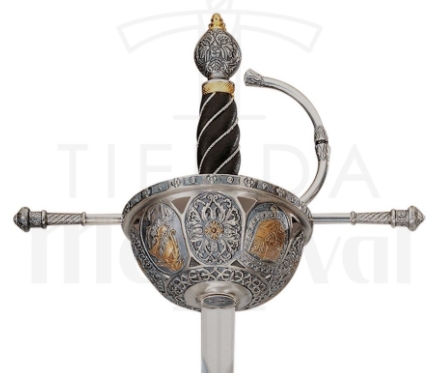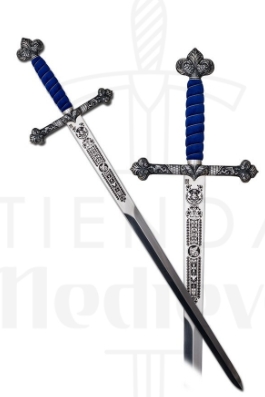Swords of Toledo (Spain) are weapons of one or two edges and basically a straight blade cutting, stabbing, or both; it has a handle of a certain size or brand and the lenght of the sword is from half a meter. According to the definition. would not be swords he katanas, the sabers or sables, etc. The word comes from the Latin “Spatha” – sword, which was used to be called the long, straight sword of the Roman cavalry.

The manufacture of these swords in the city of Toledo (Spain) dates back to roman times, but it was under Arabic domination and during the Reconquista when Toledo and its swordsmiths guilds played a key role. Between the XVth and XVIIth centuries the industry related to the manufacture of swords was very succsessful in Toledo up to the point that this industry came to be regarded as the best in Europe.

PARTS OF THE SWORD OF TOLEDO
The swords made in Toledo consist of the blade and the handle; the term scabbard designates the cover of the sword, where the sword rests when not in use.
| Blade.- Three types of attack can be performed with the blade: sting, cut and tear. The blade can be single or double edged, the latter may have a false edge near the tip. When handling the sword, the true edge or longest side is used for straight lunges, while the false edge or short side is used to counterattack. The symmetrical handgrips of some swords allow the exchange of the short side and the long side by simply turning them. |
| Handle.- The handle includes any part of the sword that allows the control and handling of the blade; it consists of the pommel and an elaborate or simple guard. The swords of the post-viking era consisted only of a cross guard called crosshead handle. |
| Scabbard.-The scabbard is the protective cover where the sword rests when not in use. During the last millenium, the scabbard was made of various materials, including leather, wood and metals like bronze and steel. The opening of the scabbard, where the sword enters, is called throat; the scabbard bears a ring which facilitates the entry of the blade. |
THE MEDIEVAL SWORD OF TOLEDO
The “spatha” type remains extended during the period of the migrations and even in the Middle Ages. The spathas of the Vendel era (Sweden 550-793) were decorated with Germanic design. The Viking Age provides, again, a more stadardized production, but the basic design ramains loyal to the spatha. Only since the XIth century, Norman swords begin to develop the quillons and the cross for the guard.

During the Crusades of the XIIth century (or XIII) this cruciforme type remains stable, with minor variations on the shape of the pommel. These swords were designed as cutting weapons, although effective tips were common in order to counter improvments in armor. The single edge Toledo swords became popular in Asia. The Korean sword Hwandudaedo derived from the Chinese Dao which became more famous in the early medieval Three Kingdoms. The Japanese katana, whose production documented in approximately 900, also derives from the Dao.
HISTORICAL SWORDS OF TOLEDO

We have assembled a large collection of faithfully evoking history swords. We highlight some of them like Catholic Kings, Columbus, Carlos V, Charlemagne or El Cid.
SWORDS OF LEGEND

Some of the swords evoke fantasy and legend, master pieces amongst them the Excalibur, Ivanhoe, Don Quixote, Robin Hood, Lancelot or Prince Valiant.

The main brands of swords in Toledo are Marto et J.L. Rubio. Another very important is Art Gladius.







